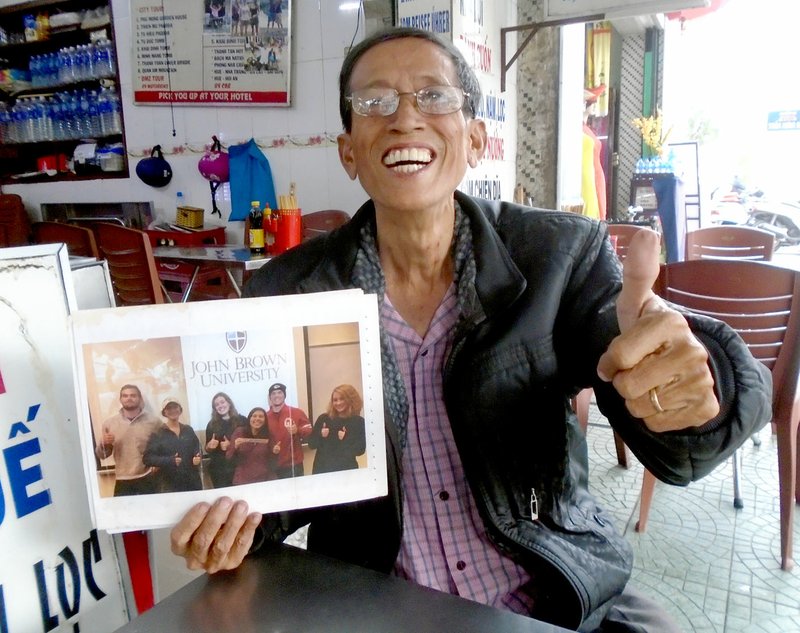DA NANG, Vietnam -- The man in the photo is named Mr. Lac. He is unable to hear, speak or read. He has no formal sign language. He communicates using gestures, facial expressions and drawings. With his family, he runs a small restaurant in the city of Hue -- about a two-hour drive from the quickly growing city of Da Nang, where I am writing this at an American-style café.
Hue is also experiencing an economic boom. At every turn in Vietnam, one is confronted by communist propaganda. But communism's days in this country are over. The people are tasting the benefits of the free market, and there's no going back.
This includes Mr. Lac, most of whose customers are tourists. Which brings us to the photo. Mr. Lac makes bottle openers of wood and screws. He gives these to customers, encouraging them to take photos of themselves with the openers elsewhere in the world, and then to send the photos to him by traditional mail. Last week, soon after I arrived at his place, Mr. Lac opened his book of photos. The first he showed me came from John Brown University. I had sent it to him two years before. I'm not in the photo, so he had no idea of my connection to JBU.
Neither did Mr. Lac know that he had been briefly featured in an event with Vietnam veterans at JBU that was broadcast on C-Span. By an amazing coincidence, one of the three Vietnam veterans interviewed that evening -- Kenneth Buchanan of Dover, Ark., -- had been wounded in a firefight right in front of Mr. Lac's restaurant. I showed Mr. Lac the spot in the program where his photo was shown to the audience. Then he saw the bottle opener he had given to me being given to the veteran as a memento of the place he was wounded.
This is how Mr. Lac came to understand that I was in Hue, first of all, because of an interest in the Vietnam War.
I returned to Mr. Lac's the next evening. Soon after I arrived, he sat down at my table with a pen and paper. By a combination of drawings and reenactments, he told me that he had been inside his home above the restaurant when the Tet Offensive of 1968 began. He was 7 years old. He watched as the battle raged on the street outside. At first, North Vietnamese forces held the street. He counted four dead in front of his restaurant. Later the Americans took the street. At one point, the building next to his restaurant was hit by artillery and part of it collapsed on an American sitting in a vehicle. The American lost his legs.
Mr. Lac described all with signs and gestures. The agony on his face as he described the Marine losing his legs marked one of the most powerful moments I've experienced in 20 years of talking with people who have survived war.
Siloam Springs residents were in or near Hue at the time. Jerry Toler was an Army crew chief aboard Chinook helicopters. Mike Bryant, whose time as a student at JBU was broken up by a tour in Vietnam, flew helicopters with the Marines Corps. Chuck Lankford served with the Navy on the Perfume River, which runs through the city.
Mr. Lac would be delighted to see these and other American veterans at his restaurant. (I wish I had the means to make that happen.) And the fact that the photo from JBU is at the top of Mr. Lac's collection seems to indicate the importance to him of being in the consciousness of young Americans.
The Vietnam War continues in some ways--the brutalizing memories, the enduring effects of Agent Orange, the bitterness. But the Vietnam War is also over. Mr. Lac's place is open for business. The same is increasingly true of this country as a whole.
-- Preston Jones teaches at JBU and provides content for the site "War and Life: Discussions with Veterans."
General News on 01/22/2020

